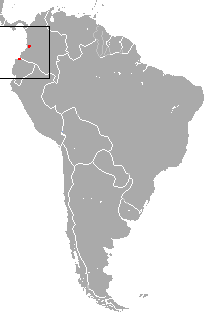| Ecuadorian sac-winged bat | |
|---|---|
| Scientific classification | |
| Kingdom: | Animalia |
| Phylum: | Chordata |
| Class: | Mammalia |
| Order: | Chiroptera |
| Family: | Emballonuridae |
| Genus: | Balantiopteryx |
| Species: | B. infusca |
| Binomial name | |
| Balantiopteryx infusca (Thomas, 1897) | |
 | |
| Ecuadorian sac-winged bat range | |
The Ecuadorian sac-winged bat (Balantiopteryx infusca) is a species of sac-winged bat in the family Emballonuridae. It is found in Colombia and Ecuador. [2] According to the IUCN Red List of Threatened Species, the population trend is decreasing for this species, due to habitat destruction through deforestation. [1] In 2013, Bat Conservation International listed this species as one of the 35 species on its worldwide priority list for conservation. [3]
